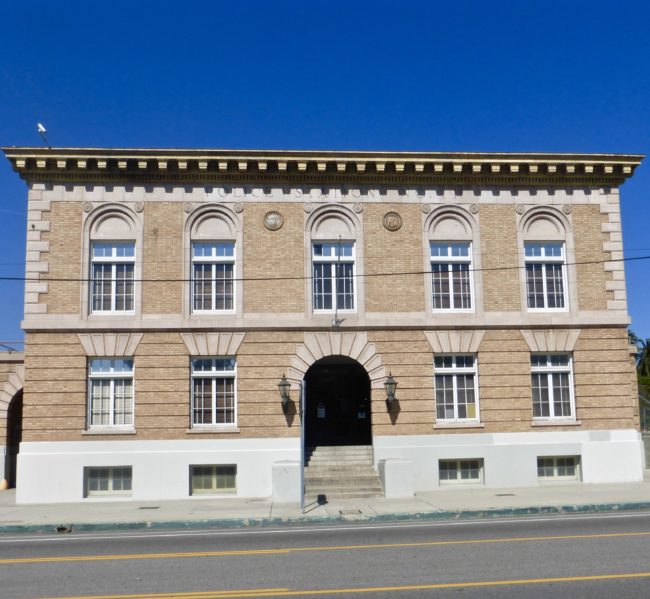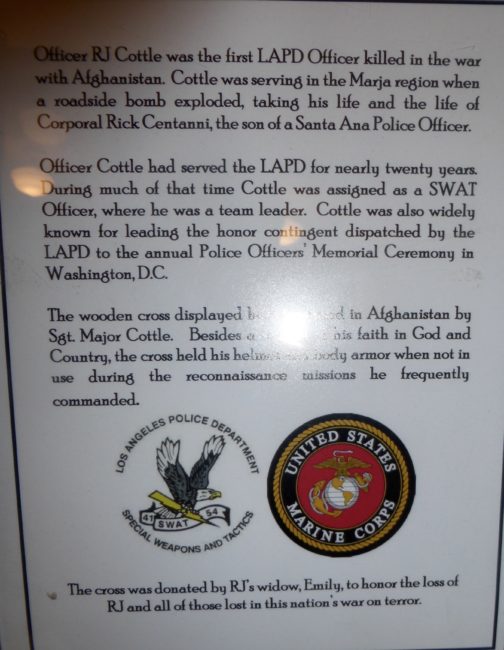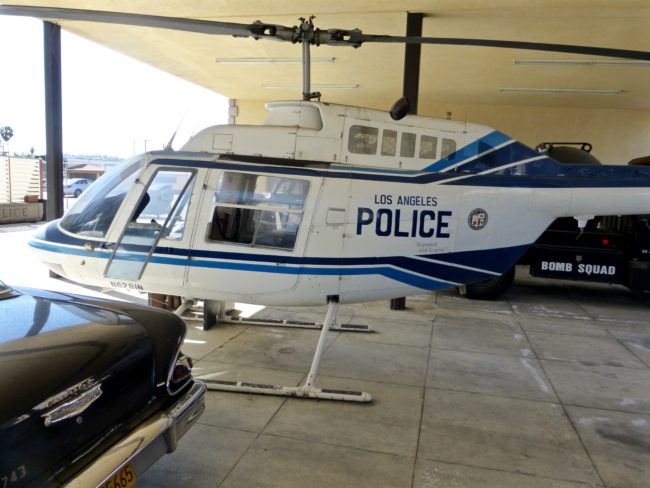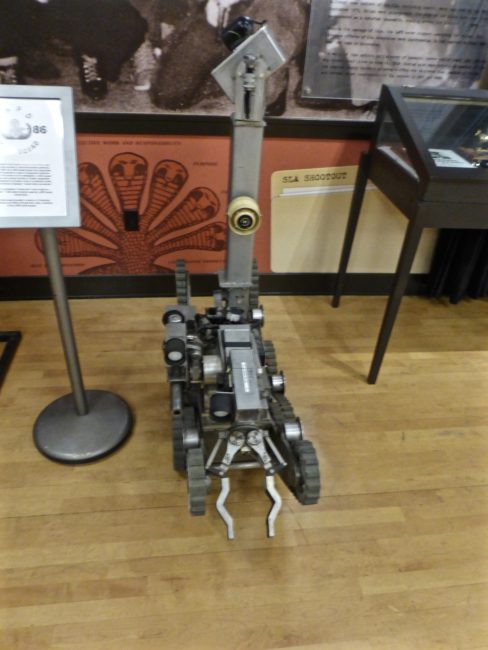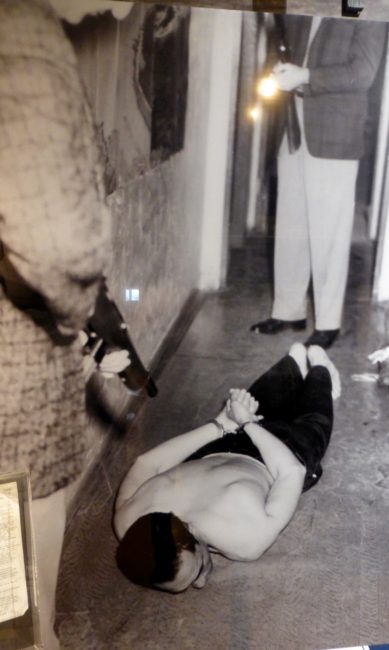
All Saints Episcopal Church – Pasadena
February 17, 2017
Greystone Mansion & Gardens – Beverly Hills
April 10, 2017An Arresting Museum
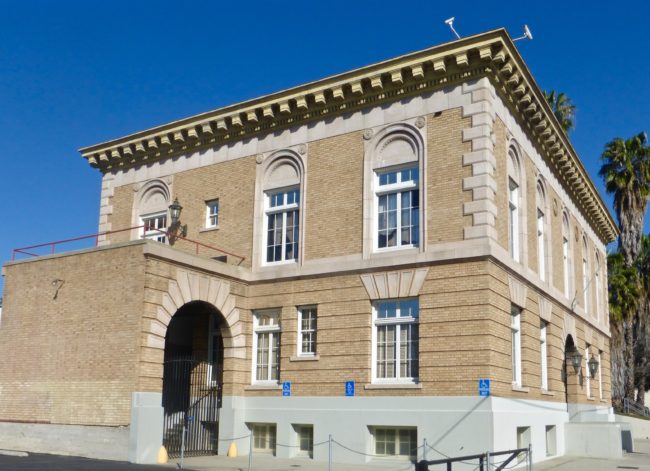 Los Angeles Police Museum – Los Angeles (Highland Park)
Los Angeles Police Museum – Los Angeles (Highland Park)
This is the city…Los Angeles, California. The story you are about to read is true. None of the names have been changed to protect the innocent (or guilty). It was Wednesday, March 1…another warm, winter day in the City of the Angels. I was working the day watch out of unusual museums. I found one that was open…the Los Angeles Police Museum. My name is Mai Tai Tom…I carry a camera (“dum-da-dum-dum”).
Yes, I was a Dragnet fan. “Just the facts, ma’am.”
Tracy and I had paid a quick visit to the Los Angeles Police Museum about six years ago (so a couple of photos like the one on the left are from that visit) on a “museum free day”…
…but we did not spend much time here because we tried to get as many free museums in as we could on that day (sometimes we’re frugal). A couple of weeks ago, I returned to the scene of the crimes. I hoped they didn’t have the below picture of my 1950s “arrest” in Hollywood. Thanks to my dad, I was quickly bailed out, and ‘my fake ID’ charge never went on my criminal record.
 I thought about sneaking in, but this being a police museum I thought better of the idea and paid my 8 bucks, one dollar less than regular admission since I am over 62. Sadly they didn’t card me like they did when I was in college, but I digress. There is also a free audio guide.
I thought about sneaking in, but this being a police museum I thought better of the idea and paid my 8 bucks, one dollar less than regular admission since I am over 62. Sadly they didn’t card me like they did when I was in college, but I digress. There is also a free audio guide.
 Although the address is in Los Angeles, the museum is actually located in Highland Park. Built in 1926, this two-story brick Renaissance Revival building is the oldest surviving police station in Los Angeles. The location moved in 1983 when the LAPD moved its Northeast Division to a new site. The vacant station was threatened with demolition, but the Los Angeles Cultural Heritage Commission declared the building a Historic Cultural Monument (HCM #274) in January 1984. Two months later, it was also added to the National Register of Historic Places and is the only precinct police station in California listed on the National Register.
Although the address is in Los Angeles, the museum is actually located in Highland Park. Built in 1926, this two-story brick Renaissance Revival building is the oldest surviving police station in Los Angeles. The location moved in 1983 when the LAPD moved its Northeast Division to a new site. The vacant station was threatened with demolition, but the Los Angeles Cultural Heritage Commission declared the building a Historic Cultural Monument (HCM #274) in January 1984. Two months later, it was also added to the National Register of Historic Places and is the only precinct police station in California listed on the National Register.
When we visited in 2011, they had a police car outside the entrance, so I naturally assumed the position. Hey, I remember that team?
 The first exhibit I visited told about the first member of the LAPD (officer RJ Cottle) to get killed in the war in Afghanistan.
The first exhibit I visited told about the first member of the LAPD (officer RJ Cottle) to get killed in the war in Afghanistan.
Now it was time for me to go to jail. First, I had to check my weapon. Once I realized I didn’t have one, I entered the original jail cells of the Highland Park Police Station.
This is where I was booked six years ago…
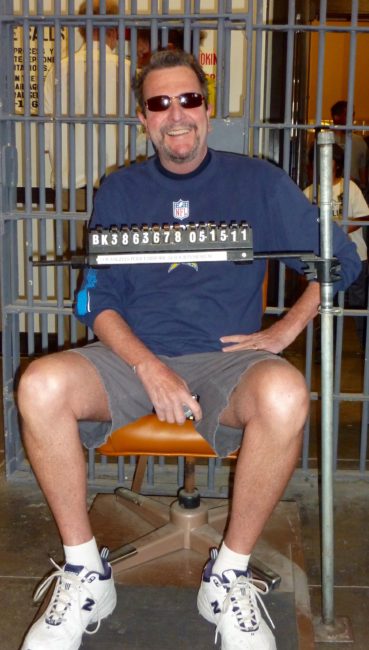 …and where Tracy was put behind bars. We both got out for good behavior.
…and where Tracy was put behind bars. We both got out for good behavior.
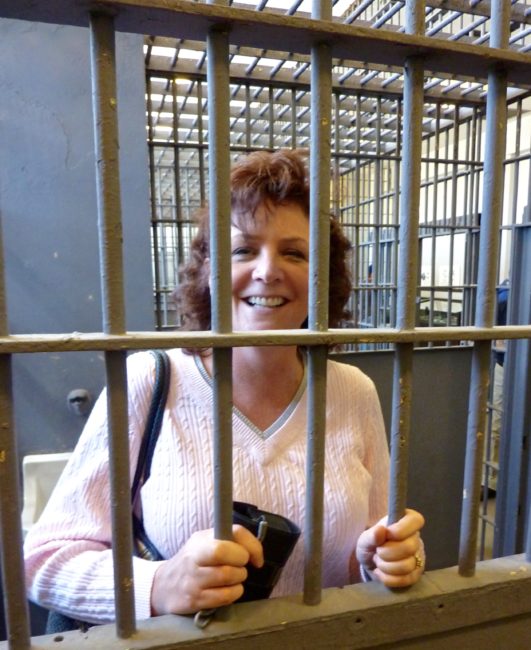 After looking inside one, a cell would not be the most comfortable place to spend time, although it did have a slight resemblance to my first dorm room.
After looking inside one, a cell would not be the most comfortable place to spend time, although it did have a slight resemblance to my first dorm room.
There is also quite a display of handcuffs and other restraining devices (photos from our first trip). I hadn’t seen this many restraints since I got rid of the Playboy Channel.
These are definitely clubs I don’t want to be a part of…ever!
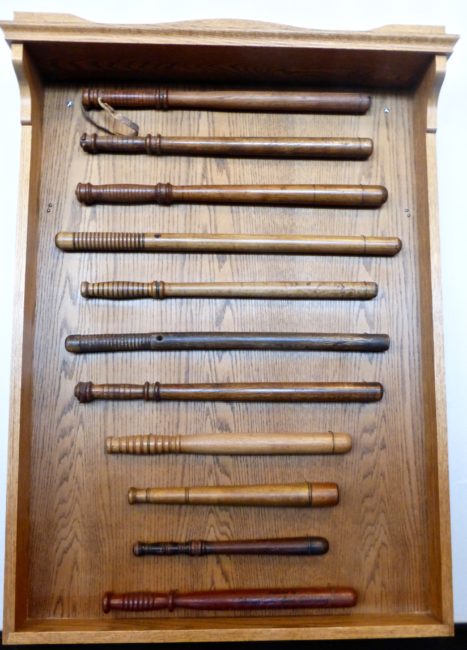 It was rather eerie, because, like so many of my adventures, I was the only person in the museum, except for the lady who checked me in. I made sure not to accidentally lock myself in a cell, not to mention no one had read me my Miranda rights.
It was rather eerie, because, like so many of my adventures, I was the only person in the museum, except for the lady who checked me in. I made sure not to accidentally lock myself in a cell, not to mention no one had read me my Miranda rights.
 Before leaving the prison area, I saw something I hadn’t seen in years. Since it was a prison, I assumed this must be an original “cell” phone.
Before leaving the prison area, I saw something I hadn’t seen in years. Since it was a prison, I assumed this must be an original “cell” phone.
Upon walking outside from the cell area, there are vintage police cars (photo courtesy of the museum, it was partially hidden the day I was there). A police helicopter…
…and a vehicle for someone who does a job that I hope they receive extra hazard pay.
 However, it was a white car riddled with bullet holes that caught my eye. It was the car used in the infamous North Hollywood Bank Of America Shootout that had taken place exactly 20 years and one day before my visit. More on that (and a couple of other famed police encounters) later.
However, it was a white car riddled with bullet holes that caught my eye. It was the car used in the infamous North Hollywood Bank Of America Shootout that had taken place exactly 20 years and one day before my visit. More on that (and a couple of other famed police encounters) later.


Back inside and before heading up the stairs to the second floor, I stopped to look at photos of the history of women in the LAPD. The audio guide spoke of Alice Stebbins Wells. A decade before women received the right to vote, Los Angeles social worker Wells became the first policewoman in the United States.
 …bomb squad equipment and gear…
…bomb squad equipment and gear…
…and a room of vintage uniforms…
 …I walked through the three most interesting displays; various rooms were highlighting three of the most notorious crimes and crime sprees that have involved the LAPD. The first few rooms chronicled the rise and fall of the Symbionese Liberation Army (SLA), a revolutionary organization that between 1973 and 1975 committed bank robberies, two murders and kidnapped newspaper heiress Patty Hearst, who later announced that she had become a member. The first room told of the 1973 murder of Oakland school superintendent Marcus Foster by the SLA and gave the profiles of SLA members
…I walked through the three most interesting displays; various rooms were highlighting three of the most notorious crimes and crime sprees that have involved the LAPD. The first few rooms chronicled the rise and fall of the Symbionese Liberation Army (SLA), a revolutionary organization that between 1973 and 1975 committed bank robberies, two murders and kidnapped newspaper heiress Patty Hearst, who later announced that she had become a member. The first room told of the 1973 murder of Oakland school superintendent Marcus Foster by the SLA and gave the profiles of SLA members
Then it moved to one of the more sensational stories of the decade, the kidnapping of Hearst, who at the time was a sophomore at Cal Berkeley. In 1974, the SLA was involved in a bank robbery that Hearst took part in.
The last room showed footage of their move to Los Angeles, and the famed shoot-out that I remember vividly from watching it on television while in college. Everybody thought Hearst was in the house, and that she was killed in the shoot-out, but Hearst was holed up in an Anaheim hotel room.
 The entire display, including the arsenal the SLA had, was fascinating. There were also a few little snippets and newspaper accounts of other notorious events, and I’ll touch on that a little more at the end.
The entire display, including the arsenal the SLA had, was fascinating. There were also a few little snippets and newspaper accounts of other notorious events, and I’ll touch on that a little more at the end.
 Another room featured the events surrounding the Onion Field murder.
Another room featured the events surrounding the Onion Field murder.
 Ex-Los Angeles Police Sergeant Joseph Wambaugh wrote a book about the incident, which was later made into a movie.
Ex-Los Angeles Police Sergeant Joseph Wambaugh wrote a book about the incident, which was later made into a movie.
The room depicts the story of LAPD officers Ian Campbell and Karl Hettinger, who after pulling over a pair of armed robbers, were kidnapped by the robbers and taken north from Los Angeles on Highway 99, to an onion field near Bakersfield. One of the robbers shot the 31-year-old Campbell to death, but Hettinger was able to escape to a farmhouse located four miles away.
 Hettinger never really recovered fully from the ordeal, suffering from survivor’s guilt and ridicule from fellow officers. According to a couple of LAPD officers, I met later as they toured the museum, he received a lot of flak from his peers because he had turned his gun over to one of the robbers, although officer Campbell had told him to do it. They also said that Hettinger was forced to visit squad rooms and publicly admit blame for his lack of courage at the onion field. Both officers said that was unfair, “because nobody can know what you’d do in that situation.” Hettinger died in 1994, and the guy who shot Campbell (below after being captured) died 18 years later in prison (his accomplice was released in the early 1980s).
Hettinger never really recovered fully from the ordeal, suffering from survivor’s guilt and ridicule from fellow officers. According to a couple of LAPD officers, I met later as they toured the museum, he received a lot of flak from his peers because he had turned his gun over to one of the robbers, although officer Campbell had told him to do it. They also said that Hettinger was forced to visit squad rooms and publicly admit blame for his lack of courage at the onion field. Both officers said that was unfair, “because nobody can know what you’d do in that situation.” Hettinger died in 1994, and the guy who shot Campbell (below after being captured) died 18 years later in prison (his accomplice was released in the early 1980s).
One of those touring officers also gave me some insight into the crazy North Hollywood Shootout of 1997, which was the last exhibit on my tour. Two guys donned body armor, robbed the Bank of America on Laurel Canyon Blvd., and then walked outside into what became a scene out of the Wild West (only with assault weapons). By the time the robbers were outside, televisions throughout the U.S. had tuned in to see how this would play out. The LAPD was outgunned. The officer watching the video with me at the museum said that after this event, drastic changes were made including providing cops with a better arsenal of weapons (below two photos from the first visit).
On that day, police had to go to a nearby gun store to borrow high-powered rifles. As the gunfight was ensuing on the video, the policeman described the strategy the officer utilized. He eventually killed one of the suspects. I could tell you that strategy, but I’d have to be killed.
 Both suspects died in the shootout, while nine police officers and three civilians were shot. Watch the footage when you visit. It’s right out of a movie, and the good guys won at the end. Be sure to check out the mannequins of the two suspects and what they were wearing.
Both suspects died in the shootout, while nine police officers and three civilians were shot. Watch the footage when you visit. It’s right out of a movie, and the good guys won at the end. Be sure to check out the mannequins of the two suspects and what they were wearing.
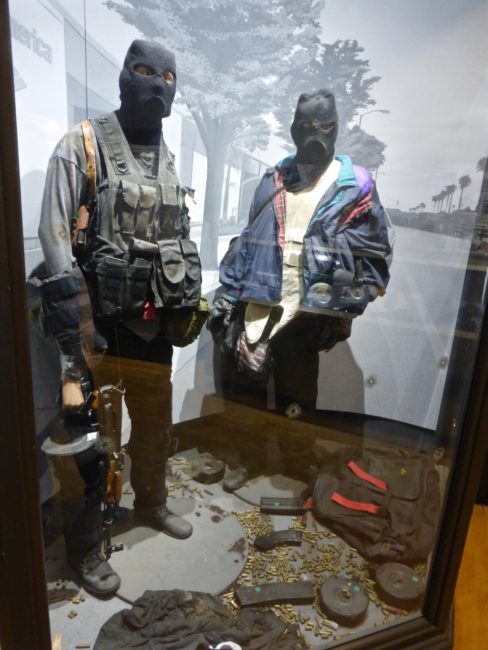 I headed downstairs for a look at some Joe Friday (Jack Webb) stuff. There was a lithograph of Friday and his famous badge number 714 (yes, the same amount of home runs by Babe Ruth). They also have Webb’s sport coat he wore on the show.
I headed downstairs for a look at some Joe Friday (Jack Webb) stuff. There was a lithograph of Friday and his famous badge number 714 (yes, the same amount of home runs by Babe Ruth). They also have Webb’s sport coat he wore on the show.
I was a little disappointed that there were no Adam-12 memorabilia, or at least “a fight with chains and knives.” (image from internet)
 One of the officers took my photo before I left. I was on my best behavior as I certainly did not want to be involved in any arrested development.
One of the officers took my photo before I left. I was on my best behavior as I certainly did not want to be involved in any arrested development.
 After viewing the photo, I also believe I should check and see if all my shirt buttons are buttoned before going out in public.
After viewing the photo, I also believe I should check and see if all my shirt buttons are buttoned before going out in public.
By the time I finished touring the museum, only a few other people had entered. This museum is really fantastic. It’s rather frustrating, because with so many historical events involving police that have taken place here in Los Angeles (RFK assassination, Charles Manson, The Night Stalker, celebrity murders, L.A. riots, OJ, etc.), it seems there could be so much more that could be added to the museum to make it an even better experience.
That said, my visit to the Los Angeles Police Museum was well worth the effort, time, and money. For something a little different, this is an interesting and enlightening place to lock yourself up for about 90 minutes.
Los Angeles Police Museum
6045 York Blvd.
Los Angeles, CA 90042
Phone: 323.344.9445
Hours: Tuesday – Friday 10:00 a.m. – 4:00 p.m.
Third Saturday of the Month 9:00 a.m. – 4:00 p.m.
Cost: $9 (62 & over… $8) (Under 12…Free)
Parking: Lot (Free)
laphs.org




